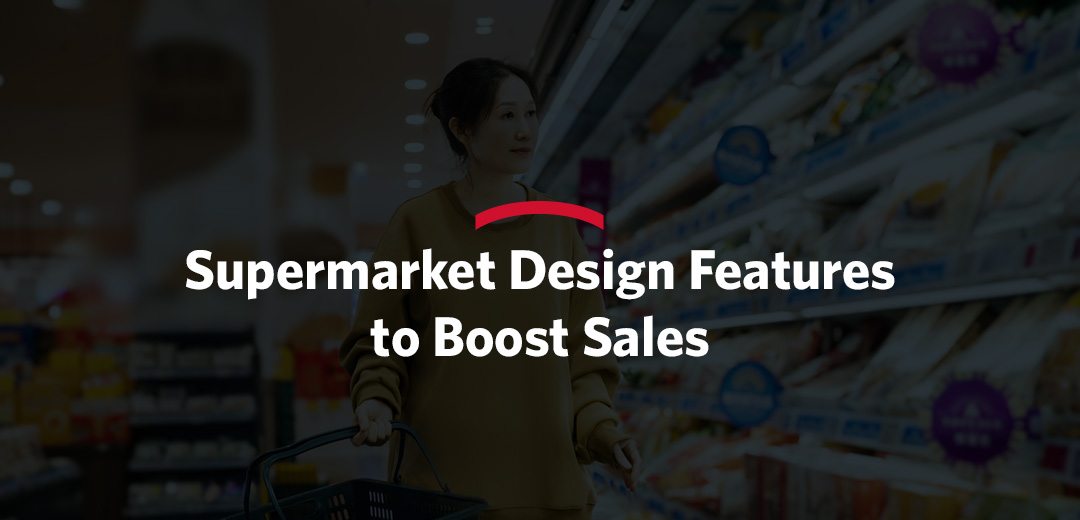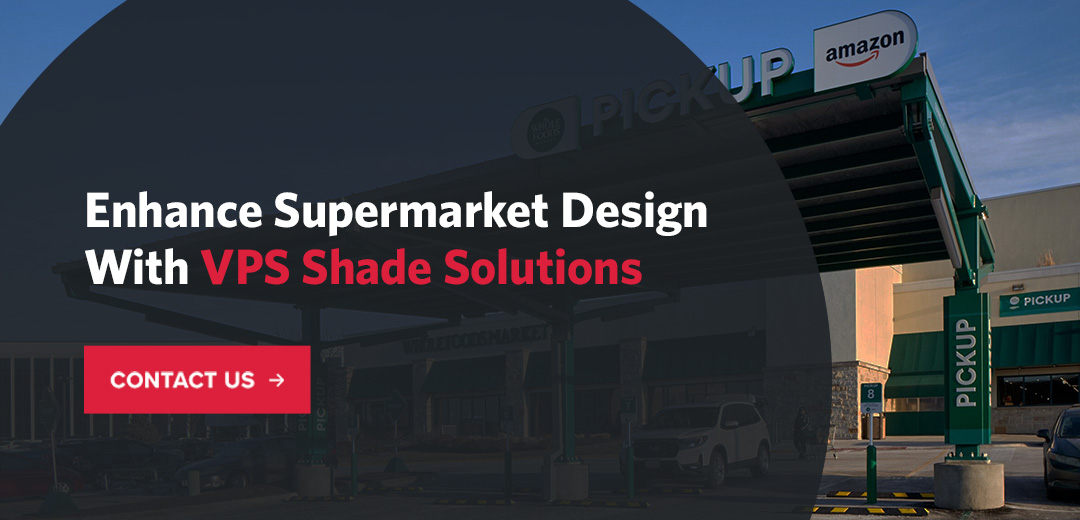Using the right design principles for a supermarket draws customers in, creates a positive branding experience, and boosts revenue for the business. The atmosphere can guide shoppers to navigate the store in a way that influences purchasing decisions and improves efficiency. Shoppers are more likely to return to a store that provides a pleasurable and comfortable experience.
Read on for the top tips to design a supermarket, from the interior to the exterior and elements for brand enhancement.
The Importance of Strategic Supermarket Design
Supermarket design is crucial for improving the shopping environment and influencing customer behavior. There are several benefits of optimizing supermarket layout and aesthetics:
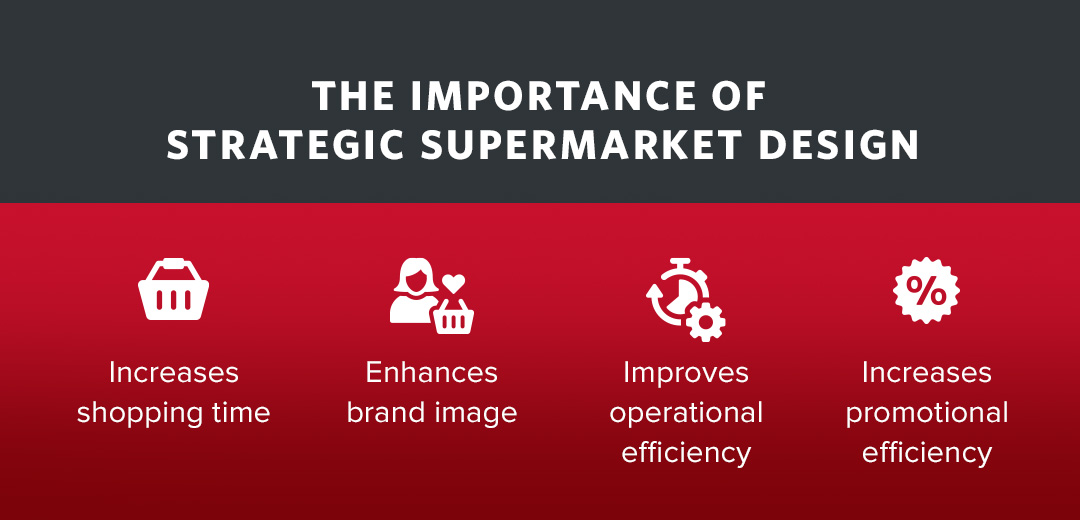
- Increases shopping time: A more comfortable supermarket design can increase the time that shoppers spend lingering in the store, encouraging further purchases.
- Enhances brand image: A well-designed supermarket creates a positive reputation and improves the store’s branding.
- Improves operational efficiency: The right design strategy can make it easier to restock shelves, keep the store neat and organized, and streamline operations.
- Increases promotional efficiency: Strategic design can draw attention to promotional items and increase visibility, making it easier for customers to identify better deals.
Interior Design Elements
The interior design of a supermarket can create a more inviting and enjoyable environment. The interior is also essential for conveying the store’s brand and helping customers resonate with the company.
Here are the top techniques to master interior design in a supermarket.
Give Shoppers a Warm Welcome
When shoppers approach the entrance of the store, it’s the ideal time to make a positive impression. The interior design for the supermarket should offer shoppers a preview of the exciting promotions and items in the welcome area. This space should display seasonal items like pumpkins in fall or trendy products that will draw customers in.
Customers who order products online need to pick their items up from the designated pickup point and may also get a glimpse of the welcome area. They might be encouraged to shop in-store in the future. Ensure that this area has accent lighting and a warm ambience that forms a comfortable environment.
Add a decompression area near the welcome space where customers can take a breather and relax before they start shopping. Ensure there’s ample seating space for tired shoppers to rest.
Create Unique Zones for Different Categories
One of the best supermarket design features to boost sales is zoning. This method gives each section a unique feel and aesthetic that makes it easier for customers to navigate the supermarket. It provides visual excitement throughout the store. Here are some tips for effective zoning:
- Create different design aesthetics for various aisles. For example, sleek lines and rustic wooden shelves would work well for the wine section, while bright colors and playful textures are excellent for the toy aisles.
- Use color schemes to signal different zones of the store, such as blue for frozen food and green for organic produce.
- Clearly define the different sections with labels and signs to make the shopping experience more efficient and easily navigable.
- Place items that are commonly used together in the same zone. That way, shoppers can easily find what they need and may be encouraged to purchase more along the way.
- Position specialty products at eye level in luxury aisles. Put high-demand products at eye level in the aisles for essential items.
- Use endcap displays to grab shoppers’ attention for festive or promotional items.
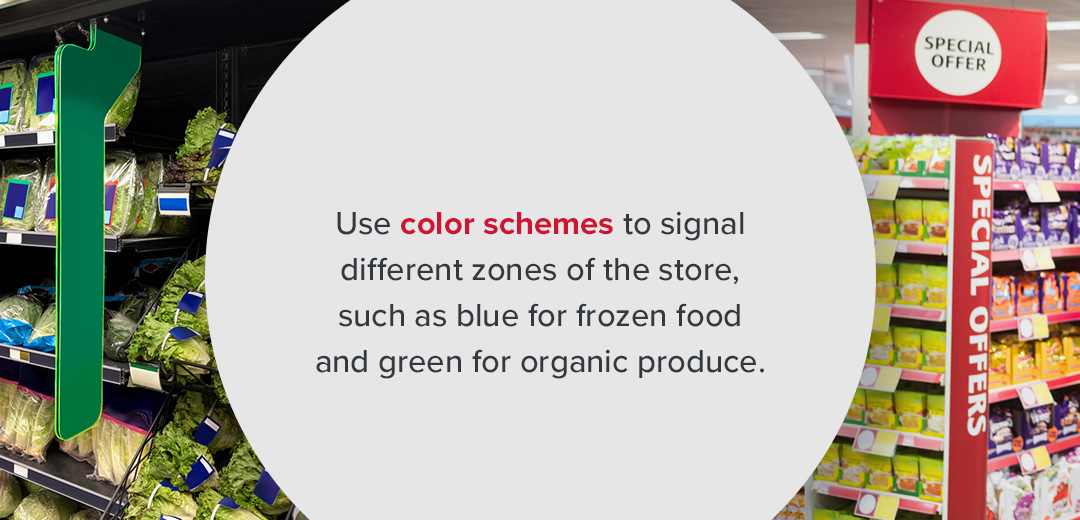
Set up a Dedicated Area for Online Orders
It’s no secret that online orders are increasing. One study found that approximately 20% of U.S. residents bought groceries online at least once in the month prior to the review. As the demand grows, it’s important to incorporate design features that make it easier for customers to pick up their orders without disrupting other operations or shoppers.
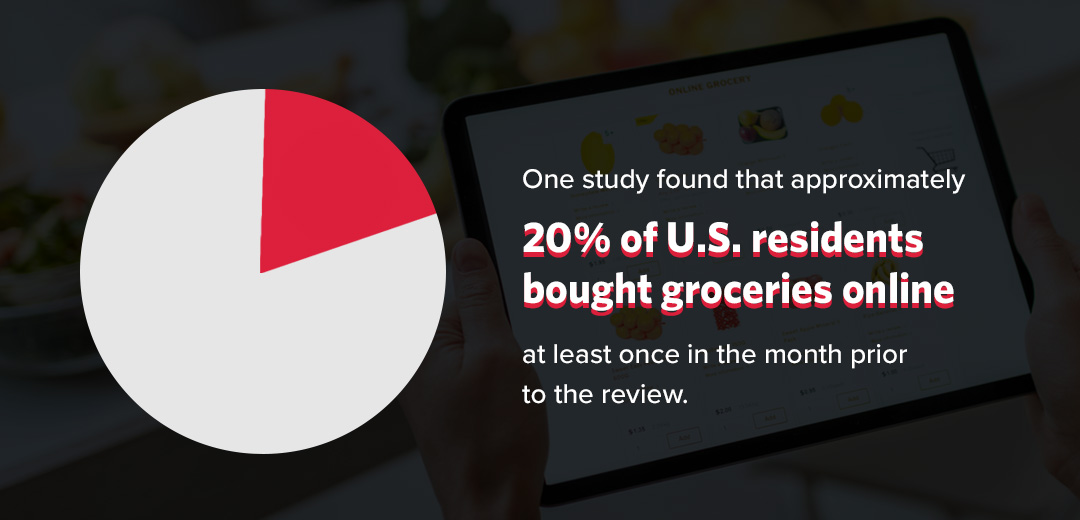
While shaded structures can help define a curbside pickup area, it’s also important to create a dedicated area inside the store. An in-store pickup area works well for delicate, sensitive, or luxury products that customers may want to pick up themselves in a secure location.
Train staff to verify orders, handle pickups, and deal with customer questions in the pickup area to deliver a smooth experience. Ensure there’s clear, directional signage that helps shoppers locate the pickup area easily. Have a timely notification system that gives customers clear instructions on where to get their order and what information they need to provide. Use packaging that is effortless for customers to pick up and easy for staff to pack.
Bring Order to Chaos With Aisle Organization
An orderly supermarket design helps shoppers navigate the store with ease. An easily navigable design encourages more purchases and helps customers enjoy their experience. Here are some common ways to organize the store:
- Thematic: This organizational style works particularly well for destination shopping experiences. It transports shoppers to new worlds in each zone. For example, there could be an “Around the World” section with imported products from different countries.
- Functional: With this style, products are arranged based on their functions. For instance, all baking products are together, and all cleaning items are placed on the same shelf. This organization method works well for convenience stores or smaller community shopping centers where shoppers tend to do in-and-out shopping.
- Departmental: This organizational style is the classic setup for many department stores and can work well for supermarkets that stock a wide variety of products. It feels like mini stores where each department has a unique identity, such as the bakery section, clothing corner, and toy area.
- Power aisle: Create a shopping highway with a power aisle featuring the hottest and newest deals that lead customers through various zones. This style is ideal for grocery stores with bulk discounts, hot promotions, and exciting offers.
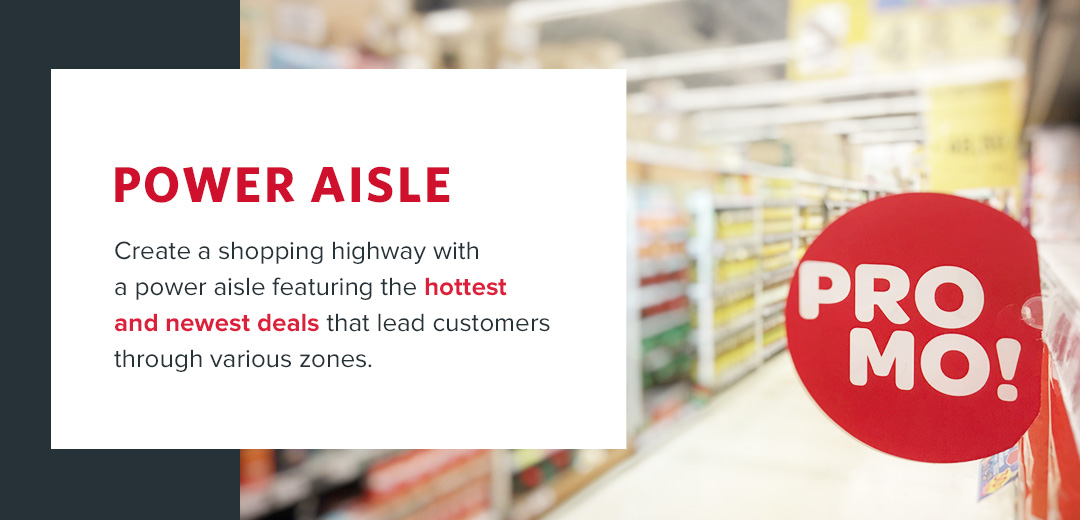
Consider Traffic Flow and Convenience
Traffic jams in a supermarket can cause shopper frustration and turn people away. Considering traffic flow in supermarket store design is crucial to prevent shopping cart crashes and allow customers to stroll through aisles during busy periods. Studies show that convenience is one of the most influential factors in consumers’ decisions to shop.
Here are some tips to make space for traffic flow and create a convenient shopping experience:
- Build wider aisles: Ensure the aisles are wide enough for multiple shopping carts to move through comfortably.
- Create an open layout: Select a design that is open and leads into other aisles easily. Avoid dead ends and confusing layouts that may frustrate shoppers.
- Hold essential items in multiple areas: Keep essentials like bread and milk in different parts of the store to prevent congestion in one location.
- Use eye-catching endcap displays: Place endcap displays strategically to guide shoppers down aisles and help them identify necessary aisles in busy times.
- Include visible signage: Use signs that are elevated and visible among the crowds so shoppers can navigate the store easily when it’s hard to see through the busyness.
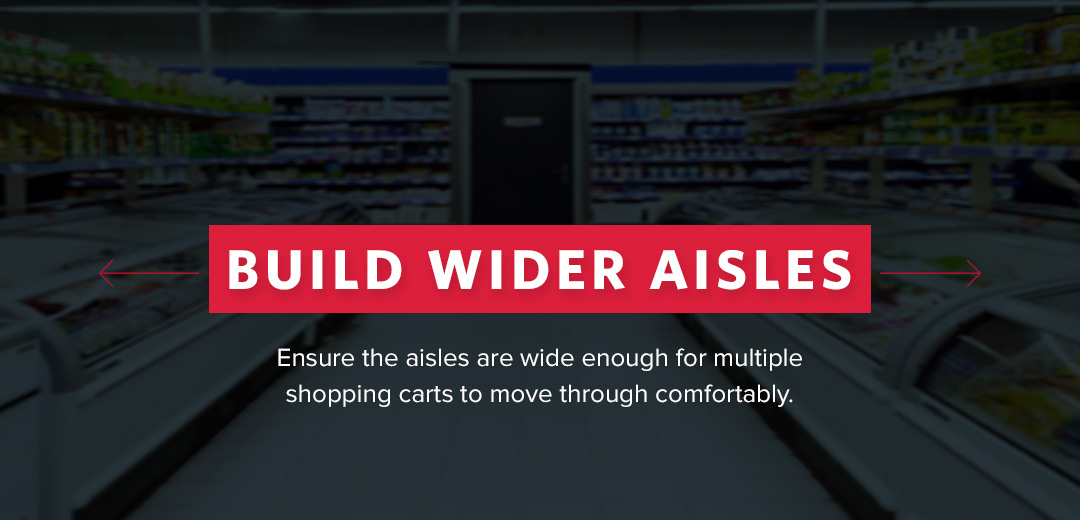
Incorporate Elements of Interior Design
The interior design of a supermarket can influence customer perception, store performance, and shoppers’ behavior. It deeply reflects company branding and should enhance functionality for staff and consumers.
Interior design principles help create a space that’s more balanced, harmonious, and cozy. A more pleasant atmosphere encourages shoppers to stay in the store for longer, shop around, and make more purchases. It also helps create consistent branding for the store by maintaining a visual appeal aligned with the company’s image.
Here are some of the top ways to incorporate elements of interior design in a supermarket:
- Choose the right colors: Colors can affect emotions and behavior, so it’s crucial to pick the right shades for a positive shopping experience. Select green shades for food aisles to convey a message of freshness and warm colors in cozy areas like the decompression zone. Use bright and stimulating colors like yellow to create excitement in the welcome area. Colors can also help make different zones more clear.
- Add natural elements: Bring in more plants and intertwine decor with natural materials like wood or bamboo to create a more relaxing space for shoppers. Keep most of the greenery in the welcome area to create a more grounding space as customers enter. It creates harmony and balance in the space by neutralizing the effects of the bright white lights and visual busyness.
- Select flooring carefully: Choose flooring that’s easy to clean and doesn’t scratch easily. Employees should be able to clean the floors effectively and quickly and maintain their appearance. Use different flooring options for various zones to define those areas clearly.
- Check the sound levels: Design isn’t just about how the store looks but also how it makes people feel. Loud noises can make the shopping experience stressful. One effective way to reduce the effect of loud noises is to play upbeat music. Studies show that consumer spending increases by over 10% in supermarkets that play music on weekdays.

Choose the Most Suitable Style
The ideal style for a supermarket depends on the demographics and interests of the consumers. If a store sees mainly younger shoppers, the interior design for that supermarket should be more modern and trendy. A more futuristic design with geometric and modular shapes would also appeal to a younger demographic.
A community supermarket that serves locals would benefit from a style that resonates with local designs. It should have a more rustic charm that makes people feel welcomed and creates a space for locals to socialize while shopping. A more upscale supermarket should have a clean and crisp aesthetic. Sleek lines, neutral tones, and a modular layout create the ideal style for this kind of supermarket.
Selecting the right style is about visual appeal, but it’s also a significant tool to solidify branding. It can help create a more memorable and recognizable brand experience for shoppers.
Offer Value-Added Services
Provide value-added services like Wi-Fi, cafes, and exciting experiences. These elements turn a store into a destination shopping experience. Grocery stores often achieve this by setting up stations with live product demonstrations, free samples, and consultations. These features make the experience more fun for shoppers and give them something to look forward to while walking through the aisle.
Pay attention to amenities like restrooms and ensure they’re always clean. Providing a positive experience through quality amenities creates a more positive association with the supermarket. Build a service counter in a space that’s easily accessible to customers so they can easily get information from staff and seek assistance.
Exterior Design Elements
The exterior supermarket design can help the company stand out from competitors and draw in more shoppers. Using the right colors, textures, and design features can tell customers all they need to know about a store before they even walk in.
Consumers are looking for welcoming spaces with fresh designs that create a sense of confidence in the brand. Here are some of the best ways to attain a supermarket exterior that pulls in more customers and keeps them happy and satisfied.
Optimize Parking Lot Layout
Consider how different types of shoppers will interact with the parking spaces and the many purposes the exterior will serve. Some shoppers may park as close to the entrance as possible to run in and grab a quick meal before heading back to the office.
Others may be looking for a parking spot that is wide enough to escort their kids and push a baby stroller toward the entrance. Many customers will likely use the parking lot for curbside pickup and would require the process to be as efficient and quick as possible.
Design consultants should ask themselves the following questions when creating the building plan for parking lots:
- Is the space sufficient to fit the desired number of parking spots while still accommodating different sized vehicles?
- What layout techniques can be applied to minimize congestion during peak traffic hours?
- Can any technologies like parking sensors or mobile apps be implemented to make it more rewarding for customers to navigate the area?
- Are there enough parking spaces that are accessible for people using wheelchairs and mobility devices? Are they close enough to the entrance?
- Is there space for bike racks and pedestrian-friendly parks for people utilizing the parking space without vehicles?
- Are loading zones sufficiently isolated from customer parking to avoid disruptions?
- Is there plenty of shade in the parking lot to keep customers comfortable while packing groceries into their cars?
Maximize Revenue With Exterior Space
With more customers utilizing online shopping and curbside pickup, there’s room for businesses to use parking spaces to increase their revenue. One popular method is to sell or lease the space out to a pop-up retailer. It pulls in more customers and creates a destination shopping experience where shoppers can enjoy a hot dog or milkshake and get their shopping done.
The supermarket owner can also use extra parking space to highlight the store’s seasonal outdoor products. For example, a lawn-and-garden tent setup could be the highlight of the summer. Put in a few plants and garden displays for shoppers to explore and encourage purchases.
Another option that’s growing in popularity is adding a gas station in the parking lot. This addition brings in more shoppers who might grab gasoline and pop into the store. It also offers more convenience for customers to fill up and get groceries in one stop. If a company decides to add these extra revenue streams, the design of the supermarket should get the spotlight. Shoppers must be able to easily spot and enter the main store.
Invest in a Solar Panel-Covered Parking Lot
One of the best ways to maximize revenue with exterior space is to install solar panels in the parking lot. It doesn’t take attention away from the store. Solar panels can also be implemented in addition to a hot dog stand or outdoor display because they don’t take up the ground space.
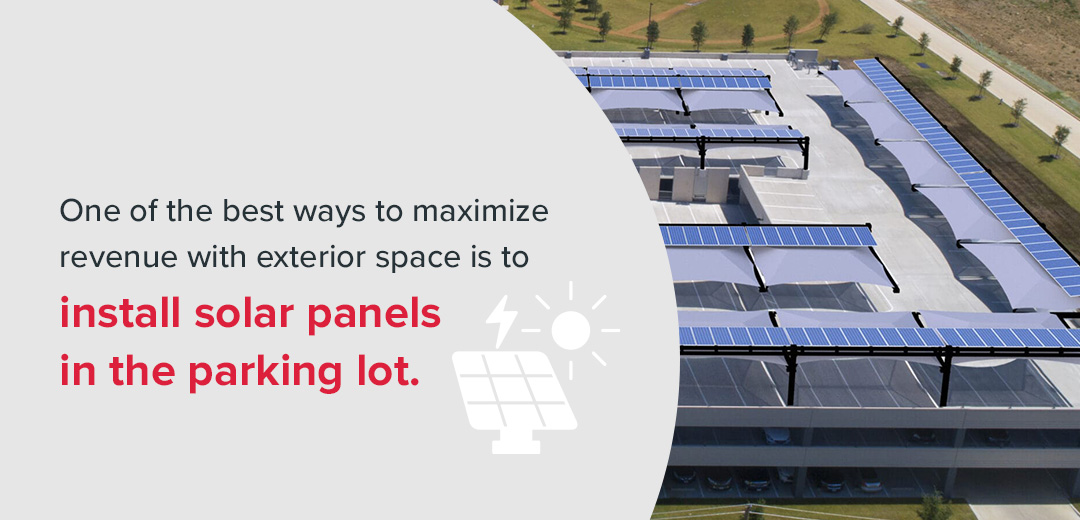
A solar panel parking lot is a win-win. Businesses can save on monthly energy and utility costs and also make extra revenue from excess energy. It also helps branding as it shows that the company is serious about reducing greenhouse gas emissions and using green energy methods.
Customers benefit from the additional shade in parking lots, which makes them more comfortable when loading groceries. It also helps keep their cars cooler. Environmentally conscious consumers will also appreciate the green initiatives the supermarket is taking. To solidify recognition as a green company, owners and consultants should include more plants in the area.
Enhance Curb Appeal
Consultants who know how to design a supermarket never overlook the importance of curb appeal. It’s where shoppers form their first impressions of the store. Most people will look for the building entry first, giving companies a chance to make a lasting positive impression. Here are some points to consider to enhance curb appeal:
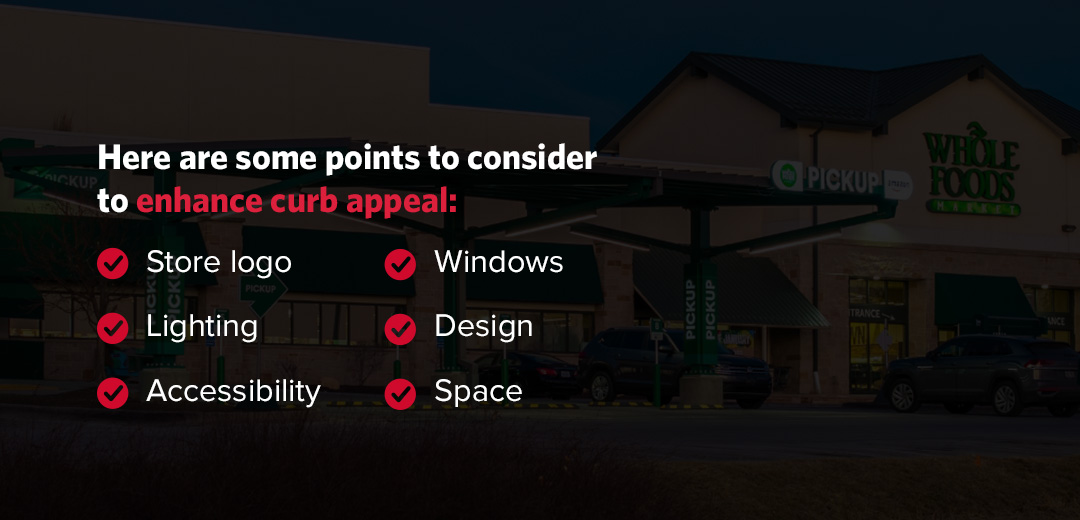
- Store logo: The store logo and name at the curb can enhance branding efforts and make the area look more professional.
- Lighting: Use lighting that allows for visibility of signs and entrances during the day or night.
- Accessibility: Provide wheelchair ramps, accessible parking spots, and other accessibility features near the curb.
- Windows: Build windows into the exterior design to add more transparency and give shoppers a sneak peek from the curb.
- Design: Incorporate unique design elements, like water features or decorative awnings, to add character and make the supermarket more memorable.
- Space: Ensure the space is big enough for curbside pickup and drivers who are fetching passengers from the store.
Create Curbside Pickup Points
With the increasing popularity of curbside pickup, it’s more important than ever for supermarkets to build a well-designed exterior. One of the most critical points of exterior supermarket design is highlighting the curbside pickup area.
This form of shopping is especially common with younger demographics like millennials. Research shows that two-thirds of millennial consumers selected curbside pickup as their preferred delivery type for online purchases.
Curbside pickup is an excellent way for stores to boost sales and customer experience. One example is the Whole Foods Market curbside pickup initiative that VPS implemented. This area enhances wayfinding with vibrant green signs under shaded, protected, and covered structures.
Curbside pickup can also enhance branding efforts and advertise promotions to encourage more shoppers to try this method. Research shows that 17% of shoppers would see discounts on curbside pickup as an enticing offer.
Enhance Supermarket Design With VPS Shade Solutions
As the market leader in parking structures, VPS is committed to enhancing exterior spaces with shade, solar panels, and visual appeal. Our innovative solutions can transform a supermarket parking space into a revenue-boosting, comfortable space that protects customers and staff from the elements. We work with clients from the initial design through the developmental stages to provide world-class solutions.
With our solar solutions and shaded structures, supermarkets can set up visible and comfortable curbside pickup areas that draw customers in and provide positive experiences.
Contact an expert at VPS today to learn more about how we can help install shaded, hail-protected, and solar panel parking structures that enhance supermarket design and revenue.
